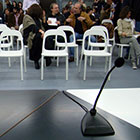Given the fact that the closure of the Postgraduate Seminar coincides with the carnival period in Greece we decided to present the design outcome related to the topic Dress and Costume: Customs and Practices of Space as a performance.
Performance
Tuesday, March 12, 2013, 21:00
Volos, Pedion Areos, Foyer, Building of the Department of Architecture
Dress / Costume: Spatial Customs and Practices
Seminar III, Postgradute Course of Studies, Architectural Design
Tutors: Evelyn Gavrilou, Iris Lykourioti
The European Center of Animation Film and the Intra-University Postgraduate Courses of Studies "Information and Communication Technologies for Education" (with the partnership of the Faculty of Early Childhood Education of University of Athens, the Faculty of Communication and Mass Media Studies of University of Athens, the Department of Architecture of the University of Thessaly and the collaboration of theDepartment of Electronics Engineering, TEI Piraeus) organize a Conference on “Audiovisual Media and Education”, at the GREEK FILM ARCHIVE,48 Iera Odos, Kerameikos, Athens, Saturday March 9th, 2013.
See the Conference program.
See the Animfest webpage and the poster of the 8th Animfest
Urban Fronts of Mexico city.
Universidad Autónoma Metropolitana- Unidad Azcapotzalco, D.F. México, División de Ciencias y Artes para el Diseño
18/02/2013 – 1/03/2013
Read the poster.
For further information and applications please contact assoc. professor Mr. Spiros Papadopoulos
Friday 26 April 2013– Thursday2 May 2013, 27/4-1/5 2013.
Institute for Environmental Education,E.N.A.O.L.I., GROSSETO, Tuscany, Italy.
Organization for the Environment LEGAMBIENTE.
TASK: some SPATIAL QUESTIONS, TANGLE POCKETS.
The last seven years there have been 9 regional, international and multinational documentation and design workshops. These workshops, as the one scheduled to be active in Tuscany-Italy, were based on the experimental verification by empirical means, of the validity of sympiosis in eutopia’s constitutional space and time terms (living and acting together into a communal pocket). The workshops are always triggered by an invitation held to the director and the team by a community or an organization (in this case the Italian Environmental Organization LEGAMBIENTE). The group, already into a new un-explored place and a unique landscape, will dedicate each and every activity (lectures, field reconnaissance, designs, texts, common long discussions) or means to effectively deal with a given spatial question. Thus, every member is becoming the vital unit of a team working process aiming to reach a result, combining the personal ability with the communal or general meditative need, interpreting and correlating with locus, landscape, cultural syntax and stereotypes ...an attempt to gain any and all empirical data of eutopia (...a term been given by Lewis Mamford in his epic book : The history of Utopias).
See the poster.
TEAM
The workshop is open to unter-graduate students in the final years of their studies, to post graduate students and young architects (who have graduated in the last five years). Participants, 20 in total, will be selected on their CV/portfolio presentation (two (2) A4 pages in PDF format).
Send material and questions to stilidis1@otenet.gr.
ACCOMODATION
The team will be host at the Institution’s facilities some 7 kilometres off the Grossetto city.
Spacious rooms for three(3) or four(4) students with common WC and Showers.
Restaurand is situated in the same complex of buildings.
WEBSITE
The presentation examines the development of the urban space in the Soviet Union at the beginning of the 20th century via its cinematic reconstructions. The various integral elements of the city are studied closely with reference to examples from literature, photography, painture and cinema in particular. These examples illustrate how the city transforms over time, with a special focus on the interwar period. The presentation focuses on Dziga Vertov's "Man with the Movie Camera" (USSR, 1929) and presents in detail the results of the shot-by-shot formalist and statistical analysis.
The presentation examines the development of the urban space in the Soviet Union at the beginning of the 20th century via its cinematic reconstructions. The various integral elements of the city are studied closely with reference to examples from literature, photography, painture and cinema in particular. These examples illustrate how the city transforms over time, with a special focus on the interwar period. The presentation focuses on Dziga Vertov's "Man with the Movie Camera" (USSR, 1929) and presents in detail the results of the shot-by-shot formalist and statistical analysis.


